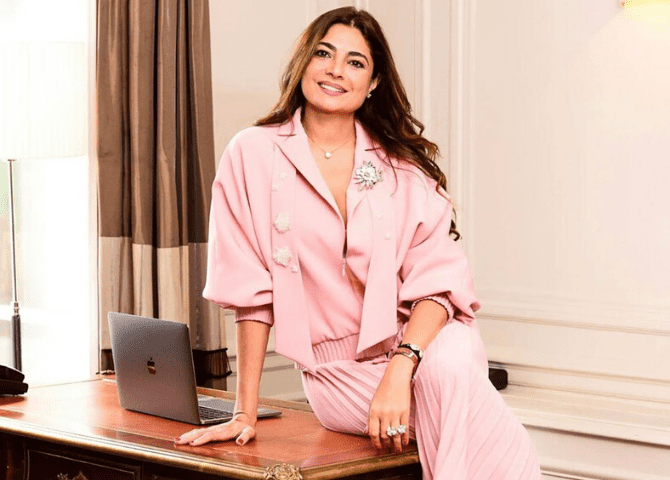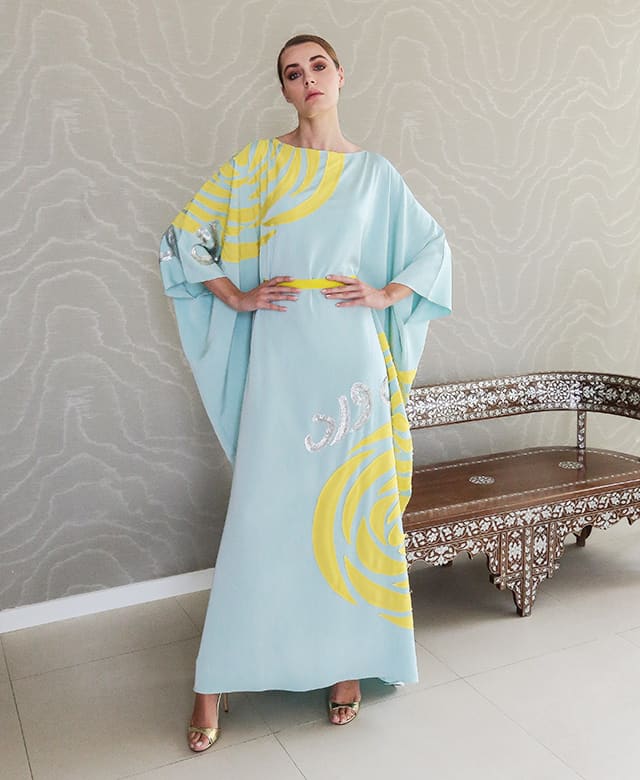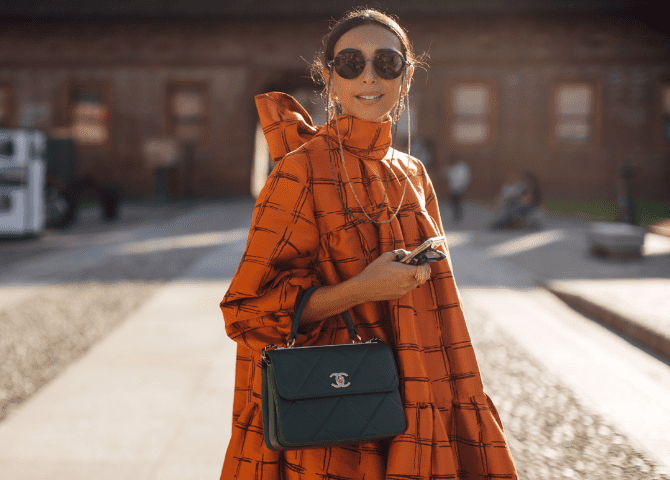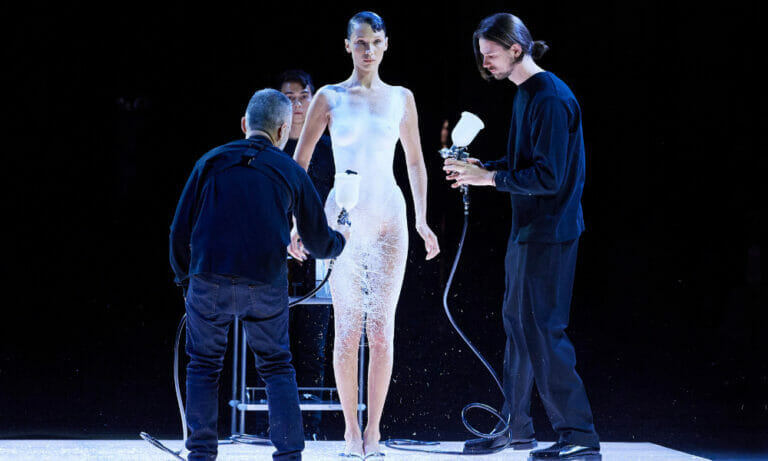It’s my pleasure to present to you one of the leading fashion designers in Saudi Arabia, Honayda Serafi. Culture has always been a strong part of Honayda’s identity. Born to an erudite family with strong links to the fine art world — her mother is a renowned fashion and art historian — she cultivated her artistic sensibilities from a young age, honing her curiosity about the world around her and developed a love for poetry, music and the arts. She is also the sister of our GEMS of ARABIA Saudi art pioneer, Founders of Athar gallery, Hamza Serafi. So, the understanding of art and beauty certainly runs in the family.
Honayda’s collections have been globally recognized and have been worn by the likes of Lupita Nyong’o and Priyanka Chopra-Jonas, to name a few. But the purpose of this article is to highlight her empathetic and philanthropic side in the hard times we are currently facing.
Honayda has always strongly believed in giving back to society and inspiring the youth to fulfil their dreams. She is an avid supporter of philanthropic initiatives, as well as a guest lecturer at leading universities, offering fashion courses for women. Her latest ‘Sketch & Give’ initiative is a unique creative artistic initiative to empower the fashion community.
Thank you for taking the time to speak to us today. Can you please tell us more about the ‘Sketch & Give’ initiative? I would like to express that it’s a very significant initiative as it gives all designers a platform to show their sketches which have not been able to be executed. It is a very authentic approach to reaching out to the design community.
Thank you, Hatem, for shedding the light on the Sketch & Give initiative. Sketch & Give’s main goal is to help the people in need by ensuring that they live the joy of Ramadan while receiving the Ramadan clothes they look forward to every year; despite the tough times we are currently living. It is a way for the fashion community in Saudi Arabia to mark these exceptional times we are living globally, by showing that even in the hardest circumstances we can still all stand for each other and be united through art, fashion and creativity.
What inspired you to come up with it?
The whole COVID-19 situation was an insight to me. Since its outbreak, it instantly hit the economy and thus the individuals, making the world more vulnerable than it was.
“Even in the most challenging times, there is always a way to offer help and make a difference in the lives of the less privileged.”
And what better way than using arts and fashion to spread love and positivity in the hearts of those facing difficulties.
Creativity is also about problem solving. Would you agree?
Problem solving is definitely a mental challenge, and creativity is constant training to the brain, it is always looking for ‘another way of’, and thinking beyond the usual.
Where do you see the fashion of Saudi Arabia heading post COVID-19?
The Saudi Arabian economy in general, got affected greatly as it is part of the world economy. And the fashion sector in Saudi Arabia got particularly hit due to the timing of the COVID-19 coinciding with the holy month of Ramadan. Our country holds a considerable number of kaftan designers which rely on the sales happening during Ramadan and unfortunately the season was killed. Since around 70% of the Saudi Arabian population is under 30, I believe that the impacts of the pandemic won’t last long as we will find ways to overcome it fast and the local economy will be picking up soon.
Moreover, the ministry of culture will be announcing shortly the formation of a Saudi Fashion Council that will hopefully play a role in the young and upcoming designers’ career and boost the Saudi fashion sector internationally.
I am one of the first Saudi women to have achieved international brand recognition in a short time (3 years), but it is my personal 20-year experience in fashion and my amazing team of experts that got the HONAYDA brand name to the world.
However, I do think that the young designers will be able to benefit from this new project that will propel them on the international scene to gain a reputable name.
What advice would you give young designers during the difficult times we are all enduring?
I will never stop telling young designers that it is the hard times that their small ‘failures’ will forge them and help them grow. It’s about their own learning process. No great designer got to the top without rocks on their way. There is an opportunity in every difficult situation, they have to keep their minds open and be ready for when the opportunity arises.
It is in these times of crisis that they should rethink their strategy and re-evaluate their brand, slow down and produce less quantities, find new ways to commercialize their products and connect with their people to keep up with their changing needs.
With closed boarders due to the global pandemic, do you see a resurgence of fashion shows or do you see everything turning digital?
On the short run, and before a vaccine is discovered and proven to be effective, I believe that not only the fashion industry but a lot of other sectors will have to turn digital to be able to stay in business.
We were actually in Paris to present to FW20 collection during Fashion Week when COVID-19 had started to spread across Europe, and although the discovery of the virus was still at early stage, we had seen a number of showrooms shut down completely, or earlier than planned in addition to a significant number of international buyers and editors who preferred not to fly over.
The way I see it, I think that fashion weeks will be suspended until at least end of 2020 and fashion brands will have no choice but to turn digital.
Going digital does not necessarily mean that the brand will lose its exclusivity. It can still give private access to its loyal stakeholders and later open the presentation to a broader public.
How important is digital vs physical collections’ presentations?
Although a digital presentation can be done in so many creative ways and truly show the beauty of each piece; for me, being in contact with the garments and feeling the textures is an essential experience.
Nonetheless, since we have created a positioning to the brand and maintained high quality and finishing throughout the years, HONAYDA has gained the trust of its customers (whether retailers or clients), and buying ‘digitally’ is no longer a barrier. Having a human contact is always better, but there are other ways to create more faithful support material such as 3D lookbooks.
What are your thoughts on sustainability? Will you plan on introducing a sustainable collection in the near future?
HONAYDA (the brand) has always implemented sustainable practices in its strategy. For instance, the brand launches two collectionsa year in line with the main fashion seasons: Spring/Summer and Fall/Winter. Fast fashion rose as a trend for the past five years or so with big design houses producing up to five collections per year – which really had to stop at some point. The real seasons weren’t relevant anymore and basically the whole industry was looping in a damaging cycle. And so I believe that if the COVID-19 pandemic had some positive impact, it would be the fact that it made the fashion industry internationally, rethink its way of producing. Even if only temporarily, renowned fashion brands are bound to reconsider the number of collections, and volume of production.
Further to sticking to two big collections per year, we have now committed to reusing our stock fabrics in the upcoming collections in order to contribute at reducing waste. There will be continuous collaborations with NGOs and we are planning special lines which sales would be exclusive funds to them.
If you could improve or change the Saudi fashion landscape, what would you do to it?
I would first start by bringing the best experienced people and the right teams of the industry, and set a clear strategy to improve the curriculum of the fashion degrees. To be able to create Saudi brands competing on international levels, it will also be necessary to improve our local factories and facilitate access to all fashion supplies.
“It is also important that we start promoting the Saudi talents internationally as they represent the image and culture of Saudi Arabia.”
Lastly, as an international brand, I always try to highlight our local talents through my relationships. The latest initiative Sketch & Give that I launched in partnership with the Saudi fashion community, aimed at shedding the light on this industry and all the amazing talent we have in Saudi Arabia.
We have great fashion institutes and departments in universities but there should be further support from the government because it’s a ground that is highly attractive to the Saudi talents, with the advantage of being a young industry and having opportunity to grow.
What has the current coronavirus outbreak taught you the most? What will be the most important experience you feel has shaped your perspective in the hard times we live in?
Difficult times unite us all as humans, and break the barriers built on races, colours, nationalities, etc. A pandemic does not differentiate people based on the language they speak or the colour of their skin, and we can always, always lend a hand to a person in need depending on each one’s capacity.
“The coronavirus outbreak taught me that social responsibility is a virtue that the humankind possesses.”
This was my insight to come up with the Sketch & Give initiative. I had the feeling that I needed to do something, and I wanted it to involve the Saudi fashion community, art and creativity, and of course the act of giving. Sketch & Give was a success because it made giving accessible as it offered a platform for all types of creatives to give to the people in need by simply expressing themselves during these tough times, through their talent.
Challenging times call for dropping the ‘I’ and standing for each other; and art unites people.
Less is more or more is more?
In fashion, less is more, whether we’re talking sustainability: less collections, less production volumes, less waste, or design: simplicity, volume, fabric combinations etc. However, in life, more is definitely more. We can never show enough emotions to those we love, or give enough to those in need, or spread enough positivity around us.
Who is your most inspiring Arab role model?
If you know HONAYDA, then you know that the brand is all about women empowerment. My role model are women at large. They will forever be at the heart of my inspiration, for I create from and to them. Each of the HONAYDA collections tells the story of a woman who marked the course of history whether from the ancient times or our modern days. Some of the women of previous HONAYDA collections were Queen Dihya warrior from the Amazighi culture, the farmer woman of the Bedouin times, ‘Shajar Al Durr’ the Egyptian queen of pearls.
Another major supporter of the Sketch & Give initiative is the Dar Alhekma University in Jeddah. Here, we speak to the Dean of School of Design and Architecture. “We are a great duo for choosing Dar AlHekma to be part of this first of a kind initiative, an initiative which brought together the fashion community and shed light on the fashion talents within the community.”
What kind of programs are available for fashion students at Dar AlHekma and how can we build a more sustainable and effective fashion industry in Saudi Arabia ?
“At Dar AlHekma University we offer a Bachelor degree in Fashion Design, the program was established in 2010 and we have graduated over 92 students to date. To build a more sustainable and effective industry in Saudi Arabia, we need to start with the foundation. The skills and talents are there, but the opportunities and resources are limited until today.”
Discover Hatem Alakeel’s Gems of Arabia column here.
Also, read his latest interview with the visionary, the creative and the global pioneer, Rozan Ahmed.




